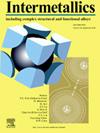异种 TiAl/Ti6-Al-4V 材料的激光焊接:快速原位激光预热对焊点微观结构和机械性能的影响
IF 4.3
2区 材料科学
Q2 CHEMISTRY, PHYSICAL
引用次数: 0
摘要
TiAl 合金在航空航天领域有着广阔的应用前景。在实际工作环境中,与其他材料连接被认为是充分发挥其优异性能的重要手段。本研究采用激光原位预扫描方法预热焊缝,实现了 TiAl 合金与 Ti-6Al-4V 的连接。在此基础上,详细分析了焊点熔合区(FZ)、熔合线(FL)和热影响区(HAZ)的微观结构演变。通过与传统焊接工艺的比较,研究了激光原位预热对焊接接头微观结构和性能的影响。结果表明,FZ 区域由 α2 和马氏体 α-Ti 组成,而 TiAl 侧的 FL 则具有 β/B2 相过渡层,为焊接接头提供了塑性和韧性。原位扫描方法减少了焊接过程中产生的裂纹,使过渡层的分布更加均匀。获得的 FZ 具有更高的显微硬度。焊接接头的室温抗拉强度达到 650 兆帕。随着温度的升高,在 400 °C 时,抗拉强度和伸长率分别达到 571 兆帕和 3%,明显高于传统焊接在相同温度下达到的 450 兆帕和 1.5%。当温度进一步升高到 500 ℃ 和 600 ℃ 时,Ti-6Al-4V 出现明显软化,成为焊接接头的薄弱点。本文章由计算机程序翻译,如有差异,请以英文原文为准。
Laser welding of dissimilar TiAl/Ti6-Al-4V materials: Effects of rapid in-situ laser pre-heating on microstructure and mechanical properties of the welding joint
TiAl alloy has broad application prospects in the aerospace field. In practical working environments, connecting with other materials is considered an important means of fully utilizing their excellent properties. This study employed a laser in-situ pre-scanning method to preheat the weld seam, achieving the connection between TiAl alloy and Ti-6Al-4V. On this basis, the microstructural evolution of the fusion zone (FZ), fusion line (FL), and heat-affected zone (HAZ) of the welded joint was analyzed in detail. By comparing with traditional welding processes, the effects of laser in-situ preheating on the microstructure and properties of the welded joints were studied. The results showed that the FZ area consists of α2 and martensitic α-Ti, while the FL on the TiAl side features a transition layer of β/B2 phases, providing plasticity and toughness to the welded joint. The in-situ scanning method reduced the cracks generated during welding, resulting in a more uniform distribution of the transition layer. The obtained FZ exhibited higher microhardness. The room temperature tensile strength of the welded joint reached 650 MPa. As the temperature increased, at 400 °C, the tensile strength and elongation reached 571 MPa and 3 %, respectively, significantly higher than the 450 MPa and 1.5 % achieved by conventional welding at the same temperature. When the temperature further increased to 500 °C and 600 °C, Ti-6Al-4V experienced significant softening, becoming the weak point of the welded joint.
求助全文
通过发布文献求助,成功后即可免费获取论文全文。
去求助
来源期刊

Intermetallics
工程技术-材料科学:综合
CiteScore
7.80
自引率
9.10%
发文量
291
审稿时长
37 days
期刊介绍:
This journal is a platform for publishing innovative research and overviews for advancing our understanding of the structure, property, and functionality of complex metallic alloys, including intermetallics, metallic glasses, and high entropy alloys.
The journal reports the science and engineering of metallic materials in the following aspects:
Theories and experiments which address the relationship between property and structure in all length scales.
Physical modeling and numerical simulations which provide a comprehensive understanding of experimental observations.
Stimulated methodologies to characterize the structure and chemistry of materials that correlate the properties.
Technological applications resulting from the understanding of property-structure relationship in materials.
Novel and cutting-edge results warranting rapid communication.
The journal also publishes special issues on selected topics and overviews by invitation only.
 求助内容:
求助内容: 应助结果提醒方式:
应助结果提醒方式:


